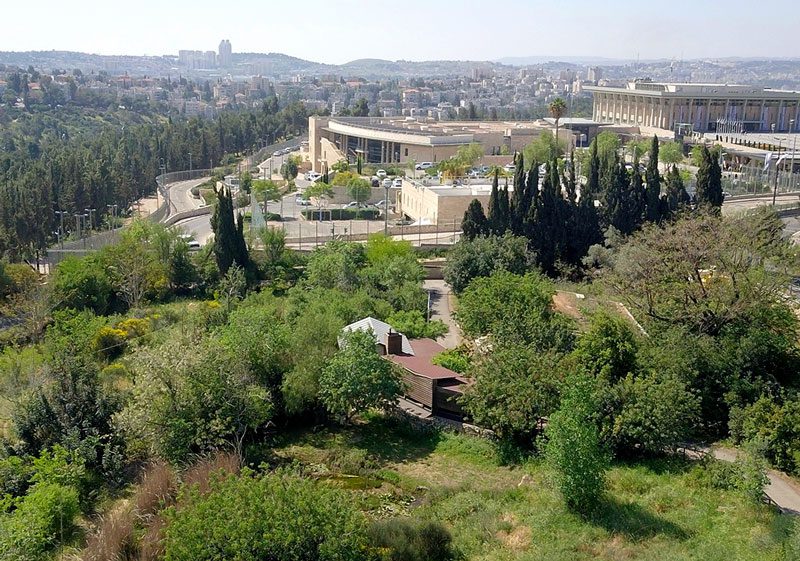Birding in Jerusalem: An Ancient City with 300 Bird Species
By Annie Novak
Eurasian Hoopoe by Miriam Baril/Macaulay Library; View from Armon Hanatziv Promenade/Alamy. January 9, 2020From the Winter 2020 issue of Living Bird magazine. Subscribe now.
Jerusalem is the world’s fastest-growing tourism market, according to Bloomberg News. It’s easy to see why, with a history that goes back to the time of King David and a rich mix of cultural and religious attractions that are globally unique. Bird watchers may visit Jerusalem for nonavian reasons—an inspirational trip to soak up this ancient city’s sights and sounds, or just to accompany a significant other on their trip-of-a-lifetime tour. But binoculars should be packed in the luggage, too, because Jerusalem offers something rare among the world’s top tourist cities: a bird list pushing 300 species, and during migration the opportunity to catch a glimpse of birds from three continents (Europe, Asia, and Africa).
“There are few places in the world where bird migration is so powerful and visible,” says eBird field reviewer Yoav Perlman. “And few places in the Western Palearctic where, within such a small area, so many bird species can be seen.”


Start By Seeing Jerusalem’s Birds Close At Hand


In Jerusalem, birders can go sightseeing in the heart of the city’s national-monuments district and still add rare birds to their life list. The Nili and David Jerusalem Bird Observatory in Sacher Park (Rothschild Street, Jerusalem) is located in the hilly Givat Ram neighborhood near some of Jerusalem’s top attractions, including the Israel Museum, which houses the Dead Sea Scrolls. Each spring, from approximately 6 a.m. to 10 a.m., visitors to the observatory’s Ariel Ringing and Research Station are welcome to watch as trained staff capture and place leg bands on migrating birds for data collection (called “bird ringing” outside of the U.S.).
“It’s incredible to see tiny wild birds so close at hand. Plus, there are really nice people to explain what’s going on,” says Jerusalem Bird Observatory volunteer Eli Philip. Migratory birds from all over Europe, Asia, and Africa can be seen here, including Eurasian Blackcap, Lesser Whitethroat, and other Old World warblers. More than 200 bird species in all have been banded here. Perlman says visitors to the Jerusalem Bird Observatory’s banding operation stand a good chance of encountering shy species that they might not ordinarily get to see, such as the secretive Olive-tree Warbler.
Whether or not banding is in session, there’s great birding to be had on the observatory grounds (open 24 hours a day, year-round), which include a bird blind, a permanent water feature, and a hillside garden with native plants rich with fruits and seeds. The one-acre landscape is a magnet for migrating Masked and Red-backed Shrikes, Thrush Nightingales, and Eurasian Wrynecks, as well as local species like Palestinian Sunbird and Eurasian Hoopoe (the national bird of Israel). The site’s wetland hosts gorgeous resident White-throated Kingfishers. Hawfinches are uncommon in most of Israel, but regularly seen here (look for their “huge, olive-pit-cracking bill,” says Perlman).
Throughout the day, the wheelchair-accessible observatory site hosts activities such as nature photography workshops. Before getting started, Perlman suggests stopping by the Gutman Visitor Center (9:00 a.m.–3:00 p.m., Mon–Thur) to check in with the enthusiastic staff for tips, or to pick up a pocket guide for plants and other local taxa.
Go Birding, And Picnicking, In Gazelle Valley Park
Gazelle Valley Park, a 250-acre open space in the heart of Jerusalem, has a network of contemporary open-air shelters, outfitted with comfortable cushions and curtains framing the rocky hills and wetlands. On your way to the park, pick up goodies for your picnic lunch from the vendors adjacent to the Delek Pat gas station (Ha-rav Herzog 1). The unassuming food stalls sell local favorites such as Turkish borek (a stuffed pastry made with cheese, mushrooms, and potatoes), Iraqi sabich (pita filled with eggplant, tahini, and eggs), and traditional Jerusalem falafel.
Check out the park’s system of “hides” (the Eastern-Hemisphere word for blinds) to get a peek and snap pics of one of the 191 species reported on eBird here, such as Spur-winged Lapwing and White-spectacled Bulbul. The wetlands host Water Rails, Black-crowned
Night-Herons, and Little Grebes. In the summer, thousands of Common Swifts come here to drink.
While in the valley, also keep an eye out for the park’s namesake, the Palestinian mountain gazelle. A delicate species of antelope, these gazelles are at home in this green slice of Israel’s largest metropolitan area, thanks to the conservation efforts of the Society for the Protection of Nature in Israel, which worked with the city to establish the park for the gazelles in 2015.


Do A Little Night Birding In Jerusalem’s Old City
When night falls over the high walls and narrow streets in Jerusalem’s Old City, time stands still as the muezzins call and the smell of incense drifts from church and temple doorways. At the Western Wall, Common Swifts and Tristram’s Starlings (a regional specialty) use the cracks in the stone wall as nesting sites. After dark, spotlights illuminating the holy site attract insects, and hundreds of swifts fly out after them for a feast.
If watching all these birds chow down inspires a little hunger, try Arafat Hummus (Shuk ha-Basamim Street) just a short walk away. For a bit of night magic, Perlman says, take a stroll in the zone between the Old City and the New City.
“The vista from Armon Hanatziv Promenade of the Old City, the New City, and eastward toward the Judean Desert is especially breathtaking,” Perlman says.
Annie Novak writes about the connections between people, agriculture, and ecology. Her March 2019 trip to Palestine and Israel included good looks at her favorite bird, the Isabelline Wheatear.


All About Birds is a free resource
Available for everyone,
funded by donors like you







